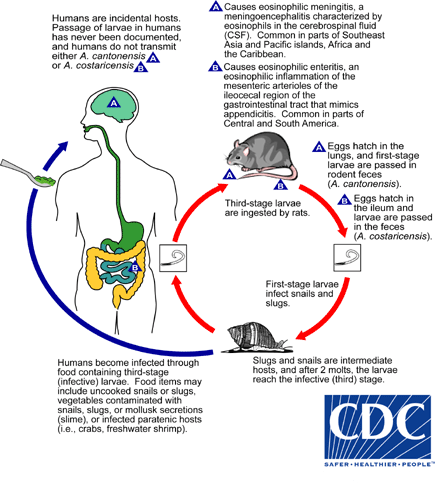Angiostrongyliasis
|
Angiostrongyliasis Microchapters |
|
Diagnosis |
|---|
|
Treatment |
|
Case Studies |
|
Angiostrongyliasis On the Web |
|
American Roentgen Ray Society Images of Angiostrongyliasis |
For patient information click here
Editor-In-Chief: C. Michael Gibson, M.S., M.D. [1]
Overview
Historical Perspective
Classification
Pathophysiology
Causes
Differentiating Angiostrongyliasis From Other Diseases
Epidemiology and Demographics
Risk Factors
Natural History, Complications and Prognosis
Diagnosis
History and Symptoms | Physical Examination | Laboratory Findings | Other Imaging Findings | Other Diagnostic Studies
Treatment
Medical Therapy | Surgery | Primary Prevention | Secondary Prevention | Future or Investigational Therapies
Case Studies
Related Chapters
Transmission
Transmission of the parasite is usually from eating raw or undercooked snails or other vectors. Infection is also frequent from ingestion of contaminated water or unwashed salad that may contain small snail and slugs, or have been contaminated by them. Therefore it is very important to avoid raw snails, wash and cook vegetables thoroughly, and avoid open water sources that may be contaminated.
Reservoirs
Rats are the definitive host and the main reservoir for A. cantonensis, though other small mammals may also become infected. While angiostrongylus can infect humans, humans do not act as reservoirs since the worm cannot reproduce in humans and therefore humans cannot contribute to their life cycle.[1]
Vectors
A. cantonensis has many vectors, with the most common being several species of snails, including the giant African land snail (Achatina fulica) in the Pacific islands and snails of the genus Pila in Thailand and Malaysia. The golden apple snail, A. canaliculatus, is the most important vector in areas of China.[2] Freshwater prawns, crabs, or other paratenic, or transport, hosts can also act as vectors.[1]
Incubation period
The incubation period in humans is usually from 1 week to 1 month after infection, and can be as long as 47 days.[3] This interval varies, since humans are intermediate hosts and, the life cycle does not continue predictably as it would in a rat.[1]
Morphology
A. cantonensis is a nematode roundworm with 3 outer protective collagen layers, and a simple stomal opening or mouth with no lips or buccal cavity leading to a fully developed gastrointestinal tract.[4] Males have a small copulatory bursa at the posterior. Females have a “barber pole” shape down the middle of the body, which is created by the twisting together of the intestine and uterine tubules. The worms are long and slender - males are 15.9-19 mm in length, and females are 21-25 mm in length.[5]
Life cycle
The adult form of A. cantonensis resides in the pulmonary arteries of rodents, where it reproduces. After the eggs hatch in the arteries, larvae migrate up the pharynx and are then swallowed again by the rodent and passed in the stool. These first stage larvae then penetrate or are swallowed by snail intermediate hosts, where they transform into second stage larvae and then into third stage infective larvae. Humans and rats acquire the infection when they ingest contaminated snails or paratenic (transport) hosts including prawns, crabs, and frogs, or raw vegetables containing material from these intermediate and paratenic hosts. After passing through the gastrointestinal tract, the worms enter circulation.[3] In rats, the larvae then migrate to the meninges and develop for about a month before migrating to the pulmonary arteries, where they fully develop into adults.[1]
Humans are incidental hosts; the larvae cannot reproduce in humans and therefore humans do not contribute to the A. cantonensis life cycle. In humans, the circulating larvae migrate to the meninges, but do not move on to the lungs. Sometimes the larvae will develop into the adult form in the brain and CSF, but they quickly die, inciting the inflammatory reaction that causes symptoms of infection.[1]
-
Angiostrongyliasis Life Cycle
Adapted from CDC
